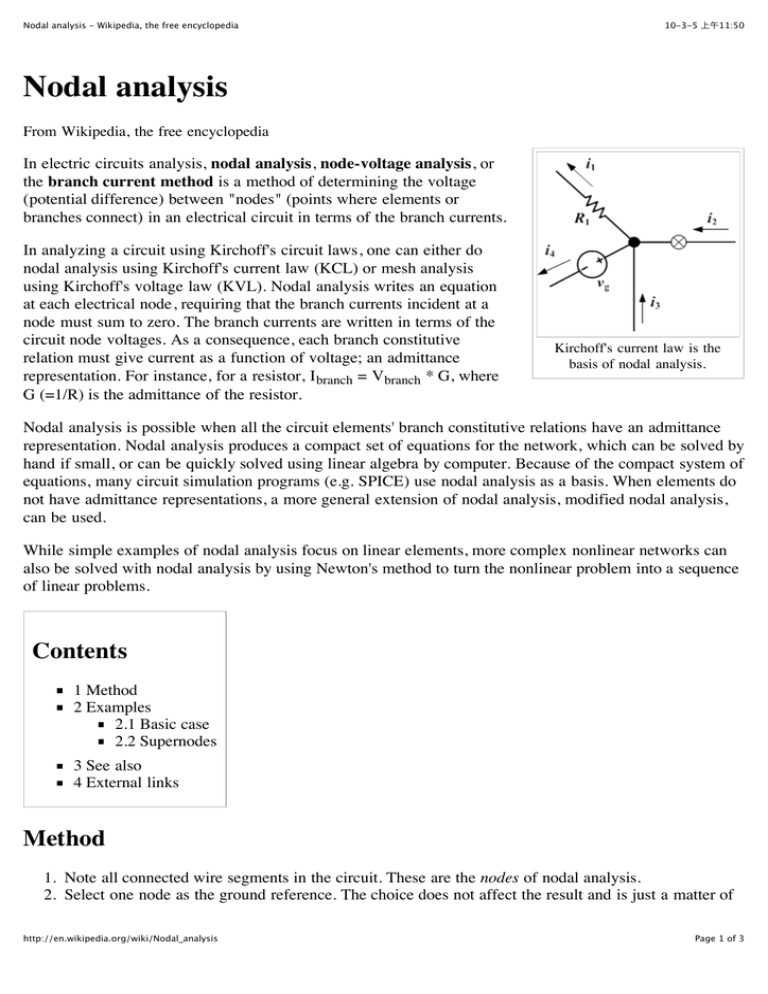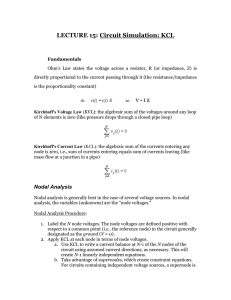Nodal analysis - Wikipedia, the free encyclopedia
advertisement

Nodal analysis - Wikipedia, the free encyclopedia 10-3-5 上午11:50 Nodal analysis From Wikipedia, the free encyclopedia In electric circuits analysis, nodal analysis, node-voltage analysis, or the branch current method is a method of determining the voltage (potential difference) between "nodes" (points where elements or branches connect) in an electrical circuit in terms of the branch currents. In analyzing a circuit using Kirchoff's circuit laws, one can either do nodal analysis using Kirchoff's current law (KCL) or mesh analysis using Kirchoff's voltage law (KVL). Nodal analysis writes an equation at each electrical node, requiring that the branch currents incident at a node must sum to zero. The branch currents are written in terms of the circuit node voltages. As a consequence, each branch constitutive relation must give current as a function of voltage; an admittance representation. For instance, for a resistor, I branch = Vbranch * G, where G (=1/R) is the admittance of the resistor. Kirchoff's current law is the basis of nodal analysis. Nodal analysis is possible when all the circuit elements' branch constitutive relations have an admittance representation. Nodal analysis produces a compact set of equations for the network, which can be solved by hand if small, or can be quickly solved using linear algebra by computer. Because of the compact system of equations, many circuit simulation programs (e.g. SPICE) use nodal analysis as a basis. When elements do not have admittance representations, a more general extension of nodal analysis, modified nodal analysis, can be used. While simple examples of nodal analysis focus on linear elements, more complex nonlinear networks can also be solved with nodal analysis by using Newton's method to turn the nonlinear problem into a sequence of linear problems. Contents 1 Method 2 Examples 2.1 Basic case 2.2 Supernodes 3 See also 4 External links Method 1. Note all connected wire segments in the circuit. These are the nodes of nodal analysis. 2. Select one node as the ground reference. The choice does not affect the result and is just a matter of http://en.wikipedia.org/wiki/Nodal_analysis Page 1 of 3 Nodal analysis - Wikipedia, the free encyclopedia 10-3-5 上午11:50 convention. Choosing the node with most connections can simplify the analysis. 3. Assign a variable for each node whose voltage is unknown. If the voltage is already known, it is not necessary to assign a variable. 4. For each unknown voltage, form an equation based on Kirchoff's current law. Basically, add together all currents leaving from the node and mark the sum equal to zero. 5. If there are voltage sources between two unknown voltages, join the two nodes as a supernode. The currents of the two nodes are combined in a single equation, and a new equation for the voltages is formed. 6. Solve the system of simultaneous equations for each unknown voltage. Examples Basic case The only unknown voltage in this circuit is V1 . There are three connections to this node and consequently three currents to consider. The direction of the currents in calculations is chosen to be away from the node. 1. Current through resistor R1 : (V1 - VS ) / R1 2. Current through resistor R2 : V1 / R2 3. Current through current source I S : -I S Basic example circuit with one unknown voltage, V 1. With Kirchoff's current law, we get: This equation can be solved in respect to V1 : Finally, the unknown voltage can be solved by substituting numerical values for the symbols. Any unknown currents are easy to calculate after all the voltages in the circuit are known. Supernodes In this circuit, we initially have two unknown voltages, V1 and V2 . The voltage at the positive terminal of VB is already known because the other terminal is at ground potential. The current going through voltage source VA cannot be directly http://en.wikipedia.org/wiki/Nodal_analysis Page 2 of 3 Nodal analysis - Wikipedia, the free encyclopedia 10-3-5 上午11:50 The current going through voltage source VA cannot be directly calculated. Therefore we can not write the current equations for either V1 or V2 . However, we know that the same current leaving node V2 must enter node V1 . Even though the nodes can not be individually solved, we know that the combined current of these two nodes is zero. This combining of the two nodes is called the supenode technique, and it requires one additional equation: V1 = V2 + VA . The complete set of equations for this circuit is: In this circuit, V A is between two unknown voltages, and is therefore a supernode. By substituting V1 to the first equation and solving in respect to V2, we get: See also Mesh analysis Ybus matrix External links Branch current method (http://www.allaboutcircuits.com/vol_1/chpt_10/2.html) Four-node problem solver (http://mazlumi.webng.com/node.asp) Retrieved from "http://en.wikipedia.org/wiki/Nodal_analysis" Categories: Electronic circuits This page was last modified on 4 March 2010 at 03:53. Text is available under the Creative Commons Attribution-ShareAlike License; additional terms may apply. See Terms of Use for details. Wikipedia® is a registered trademark of the Wikimedia Foundation, Inc., a non-profit organization. http://en.wikipedia.org/wiki/Nodal_analysis Page 3 of 3



